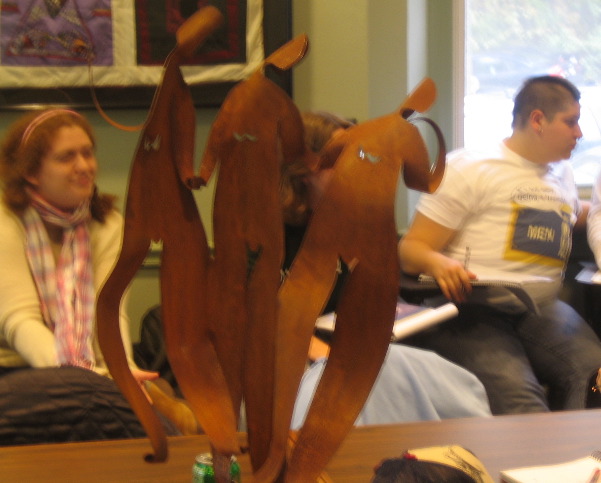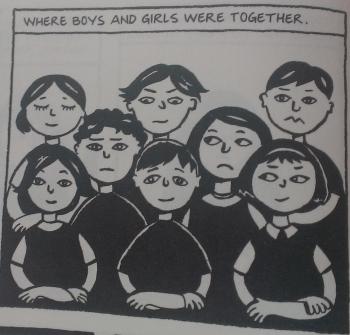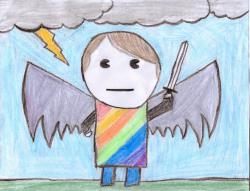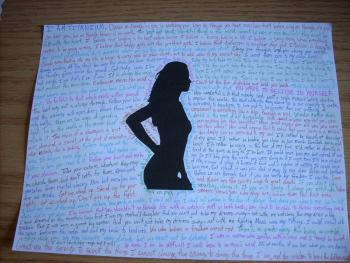Serendip is an independent site partnering with faculty at multiple colleges and universities around the world. Happy exploring!
Critical Feminist Studies 2013

 |
Welcome to the on-line conversation for Critical Feminist Studies, an introductory-level course offered in the English Department and Gender and Sexuality Program @ Bryn Mawr College in Fall 2013. |
Who are you writing for? Primarily for yourself, and for others in our course. But also for the world. This is a "public" forum, so people anywhere on the web might look in. You're writing for yourself, for others in the class, AND for others you might or might not know. So, your thoughts in progress can contribute to the thoughts in progress of LOTS of people. The web is giving increasing reality to the idea that there can actually evolve a world community, and you're part of helping to bring that about. We're glad to have you along, and hope you come to both enjoy and value our shared explorations. Feel free to comment on any post below, or to POST YOUR THOUGHTS HERE.

Mimesis In Abstract Poetry: Reflecting on Acker's "Language"
Then
I started writing in the sixth grade. Under my bed (to this day), tucked inside a plastic bin of winter sweaters, there is a green binder inked with the words “LE JOURNAL OF CHRISTINA” on the front. The first entry reads,
“December 17 2006. Hello. My name is Christina Celeste Stella. I am eleven years old and this is my diary. I attend Moravian Academy, and I think it’s safe to say that I hate it. Sometimes I can be nice, and sometimes I can be a bitch. I like to think that I’m funny, but it’s probably not true. But I do have two cats! That’s true. And a brother, and a mom and a dad, and we did just get a fish who I named Solomon. I named him that because Solomon was the name of a King, and all fish are kings of their own castles (or fish bowls, whatever Sol likes better). I have pretty cool friends. I’m in love with Derek Turner. He’s so beautiful. It’s really cold out, and I’m tired, so I’m going to bed. I love you diary! Good night. I’ll tell you how tomorrow goes. You don’t have legs, so I’m not really that worried about you being there when I wake up, and if you’re not, I’m going to call the police. Love always, Christina!”

The Duality of the Gaze: An Exploration of the Beauty and Shame Found Found in the Female Body

In 2009, I visited an art exhibition at the Austrian Cultural Forum New York, titled “The Seen and Hidden: [Dis]Covering the Veil.” The show created a clash of western and eastern cultures in order to display the controversial interpretations of what it means to be covered, objectified, and sexualized in the preconceived notions of Arabic and Islamic cultures. The pieces in the show invoked a vivid sense of both frustration and mockery at the overall confusion and misunderstanding found across the globe, which has ultimately resulted from the potent duality of the gaze.

Figuring It Out: Web Event 1
Trigger warning: sexual assault
In Neil Gaiman’s The Doll House, women are cats. Women are a lot of things in this graphic novel: protagonists, foils, stupid, smart, slut-shamed, and presented as tropes. Amongst the same old nonsense, though, Gaiman uses metonymy to describe women, while I, reading the book, was also using something to symbolize something about myself, also a woman.
Throughout The Doll House, Gaiman has a lot of people “playing” with women. The book is scattered with references to women as things that someone can play with; toying with them like playing with a cat. The women are props in his book to play out a larger story, and within the big, sweeping narrative of dreaming and waking, the women are played with even more. They are made into sex objects to be manipulated with like they are as inhuman as cats (pausing only to make the connection between “pussies” and “cats”). When serial killers in Part V of the novel meet and talk about their experiences, one goes on about starting off with “pussies” and cutting off their heads—a description that could easily reference cats or vulvas.
Gaiman draws on symbolism to make his novel more detailed on the micro-level. It fleshes out dialogue and character interaction with a running pun that references patriarchal oppression and modern day conflict. Gaiman, the author, uses symbolism in his writing. I, a student, signal sometimes explicit details about myself.

Web Event 1- Feminist Theology
Is a Christian feminist an oxymoron? I identify as a Christian. I identify as a feminist. I do not know how to completely reconcile them together. It can be easier to have these two aspects be separate. In some circles you can proudly say you are a feminist and in others affirm that you are a Christian. But then you are denying a big part of yourself if you do not acknowledge both beliefs. An issue that you’re creating for yourself is that you are hiding and choosing parts of yourself which might not be as accepted in certain circles. You are picking one over the other and in those instances saying that the other is less important. How do you deal with feminists who have a view that religion and “their ideologies, their symbolism, and above all, their established institutions stand accused of putting a stranglehold on women’s aspirations”(Soskice 1) In many ways men and organizations have used religion to put women in a subservient role. Christianity is not about making women lesser than men and feminism is not about destroying family values and beliefs that Christians hold dear. If you can find the good in theology that helps to elevate women then Christianity and feminism could become closer to being accepted together.

Web Event 1: Finding Gender in The Doll's House
We all read Kathy Acker’s essay “Seeing Gender”, which breaks down the essence of meaning (especially of gender) by questioning the process of mimesis in patriarchal language. In it she searches Lewis Carroll’s novel Through the Looking Glass for gender – but finds “only the reiterations, the mimesis of patriarchy, or my inability to be.” After reading it, I wondered – did she expect anything but a reflection, looking into a mirror? Carroll’s novel is a good example text to display the problems with patriarchal representations of gender, but I wondered if there was a text that addressed and/or transcended these problems.
Then we read Neil Gaiman’s graphic novel The Doll’s House, which offers a different way to look at gender – rather than in a mirror, through a dream. The Dream House, Morpheus’s realm, is a place of possibilities as infinite as our imaginations unlimited by social rules – some darker than we might expect. Gaiman’s dreams help us to see our psyche in a way that offers new insight on our anxiety about the roles in which we find ourselves in the waking world. They portray a self separate from social expectations of gender: a body, as Acker describes it.

Identity Fluid or Not

“I am an archaeology major and finding pottery sherds are very common. As an archaeologist it is my job to create a complete picture, a complete identity for the sherds I find. Right now I’m struggling to find my true self, my authentic identity. Right now I am a bunch of sherds waiting to be found and be put together.”
Identity Fluid or Not

Silence in Spoken Word--Web Event #1
The class is averagely sized, large by Bryn Mawr’s standards though. The atmosphere is a bit chaotic, I walk in to a whirlwind of questions and answers and voices a few minutes after the “getting to know you” activity has started. The professor says list every pronoun you know to this person across from you that you’ve never spoken to…go.

Putting Down Roots: My Journey to Ecofeminism
On the surface, Arizona’s ground is purely gravel, beneath is sticky clay and rock-hard white lime. It’s a cruel combination yielding to only the toughest and most determined, and even those somehow able to sink a root must fight for their lives under blistering sun and cloudless sky. Trying to forge a home in the desert can lead to exhaustion and hopelessness, so I readily admit to a certain degree of masochism behind my love for a place that seems, on its surface, to be the antithesis of life and nurture. Growing up in Arizona, I learned to crave the searing burn of sun on my skin, the way my nostrils stung with deep breaths of the dusty, desiccated air, but I didn’t want to belong. I watched my neighbors’ futile attempts to maintain even the sparsest of green lawn, only to become despondent as they turned to hay despite the wasted and wasteful gallons of precious water streaming from their hoses. My love for the Sonoran Desert was hardly immediate; for many years I viewed the barren landscape as a personification of my own inner despondency. I yearned to leave – rejecting the land was infinitely easier that trying to put down roots. When I did leave, however, I felt the ache of displacement immediately. I had unwittingly sunk root into ground that had once seemed impenetrable and I have discovered that beneath the rocks and clay laid a varied and complex soil that has managed, despite my protestations, to feed a soul I never acknowledged.

Web Event #1: A Question of Accessibility
If a feminist work falls in the forest and nobody can understand it, can it still be called feminist?

Gender in Children's Book Illustrations - Web Event #1
 “Girl, boy, boy, boy, girl, girl, boy, girl,” I quickly say to myself.
“Girl, boy, boy, boy, girl, girl, boy, girl,” I quickly say to myself.
On the second page of Persepolis, there is a panel reading, “where boys and girls were together,” and the illustration shows eight children (Satrapi, 4). When I read that page, I stared at the drawing trying to figure out how I knew which children were boys and which were girls. I could tell, from a simplistic drawing, based on the hairstyles and the top half of the shirts, and that bothered me. The style of the drawings and the accessibility of Persepolis reminded me of illustrated children’s books: simple sentences with drawings of what is happening.
I decided to take another look at a few children’s books I loved when I was younger. Many children’s books feature anthropomorphic characters, and I wondered how the anthropomorphic characters would be gendered compared to the human characters. The specific stories I looked at were “The Veil” from Persepolis, “Chapter VII In Which Kanga and Baby Roo Come to the Forest and Piglet Has a Bath” from Winnie-the-Pooh, The Berenstain Bears and the Sitter, Arthur Writes a Story, Clifford’s Family, and Thank you, Amelia Bedelia. The illustrations in these stories range from very humanized to actually human, and from highly gendered to barely.


Web Event 1-Silence and performance
No one has ever really understood why I have a tendency to be so quiet in class. I still don’t think that I know the logic behind it. Nonetheless, I’ve sat through countless parent/teacher conferences where my high school teachers said, “Your daughter is just so bright but she never speaks up in class” and “she’s such a shy students.” I watched as my parent’s eyes widened in complete confusion. There was no way these teachers could have been talking about their daughter; their 5”4’ ball of energy, who never seems to stop talking. This is the part of me that has never made sense. Why is it that the second I step into a classroom, my thoughts freeze and my voice immediately vanishes, leaving me empty in my chair as I listen to everyone else’s lively discussion. But take that chair out of the classroom and put it on a theater stage. Give me a script or lyrics to sing. Standing on a stage, prepared to act, sing or dance, is more freeing for me than any liberal arts college classroom has been so far. These dichotomous aspects of my personality are at war with each other, searching for a compromise between the girl whose heart bleeds on stage and fearfully shrinks in the classroom. I want to learn represent myself knowing that there is a shy student and an exuberant performer inside of me and hopefully find a compromise between classroom expectations and my own.

Grandmothers' Struggles with Google
This is a new username. It's still someone who's in the class, but it's not attached to a lot of very identifiable information (as opposed to my old one). Anne and I agreed that writing about my (maybe) queerness would be a more interesting topic than the one I initially proposed, but it's a little more clandestine than a literary analysis of The Dollhouse. I'm just starting to come out at Bryn Mawr, and people back home don't know I'm queer yet--I really don't want my grandmother to find out about this because someone in the family thinks it would be fun to teach her how to use Google, so broadcasting my name no longer seemed like such a good idea.

Web Event #1: Sister, Sister
When I was growing up, my sister and I could not have looked anymore alike visually. We had the same eyes, lips, hair type, skin tone, shoe size and much more. At the core, we were identical twins. Stylistically however, we were polar opposites. As a way to individualize ourselves from one another, we developed different tastes in clothing, toys, books, and expression. Justine was the tomboy, I was the girly girl. I loved pink, Justine hated it. Even with all of these differentiations however, we could never get rid of the fact that we were identical twins. We could make it a little less obvious, but that label would never completely go away. Not that we wanted it to, we enjoyed the benefits that came with being twins and enjoyed our similarities as well as our differences. However, the inability for us to be together without a label that neither one of had chosen nor could get rid of made for some hard times when it came to establishing ourselves as separate people. My sister and I’s failure to create identities completely independent of each other makes me question whether our identities as human beings are relational?

Web Event #1: Fear and Self-Representation
“I guess I think that maybe perhaps if you want to hear to my opinion, but I’m no expert, so I’ll make it brief…” is not an uncommon way for me to preface what I have to say. I am a strong believer that a five-minute-long disclaimer is enough to protect me from any criticism whatsoever. I believe strongly in a lot of other things, too (for one, I consider myself a feminist), but you wouldn’t know it from the way I talk. I sit there biting my fingernails, taking in what others have to say, feeling that their thoughts are much more intelligent and valid than my own. I dread being called on and sharing what I have to say, the best case being that I just said something painfully obvious and the worst case being that I said something completely wrong. I fear judgment. I fear criticism. I fear being wrong. Luckily, I’m not alone in my fears. My fear of speaking out is shared not only by other women, but many people who are marginalized by society. Fear limits self-representation to a self-preserving performance, making us unable to represent ourselves as we wish to be represented.


My anti-self-portrait essay
 Relational Definitions of Ourselves
Relational Definitions of Ourselves
When our professor proposed the idea of making an anti-self portrait, I questioned the idea because I doubted my drawing ability and I struggle with looking at myself. I am scared of what I will find there. However, when Laura Swanson mentioned it could be any medium, I realized that I am not the kind of person who can be represented by a picture, but by words. The words I chose are all inspirational quotes and lyrics either about keeping going even when it is hard, standing up for what you believe is right, or just enjoying life. The outline of the woman is a representation of me, surrounded by all of the inspiration, facing whatever challenges are coming my way and enjoying life. It is purposefully an incomplete picture of me because I defy many categories that people attempt to put me into.

web event #1: using Tumblr as a medium of self-representation
I didn’t expect anyone to take notice of my self-portait when Laura Swanson came to visit. A screenshot of a Tumblr customization page, it felt simple, despite the meaning I had given it, but when I spoke with others, they understood what I had meant. Tumblr, like many social media, stands at a peculiar intersection between personal thought and private identity, allowing users to specifically tailor their blogs to express the particular representation they choose at the time. Among women, it has a particular following; as stated by Niels van Doorn’s team: “The traditionally ‘feminine’ act of diary writing…is adopted by both men and women, challenging the traditional understanding of technology and the Internet as masculine territories.” Thus, it allows for a specific niche where users of any gender can express themselves in the manner that they choose. Through Tumblr, when one has the opportunity to match an identity to a real life face, it can express hidden facets of a personality one is unable to share in daily physical contact, allowing a kind of freedom for users using it to get away from their typical life.

Bryn Mawr College: A look at the representation of race (web event 1)
A fact about owls: their eyes are fixed in their sockets, which means they must turn their entire head to see in a different direction. Like the owl, we often only see what is presented in front of us, but sometimes we must turn our heads in order to gain a fuller perspective of the people and world around us.
Part of the Bryn Mawr College mission “seeks to sustain a community diverse in nature and democratic in practice” believing that “considering many perspectives we gain a deeper understanding of each other and the world.” It is through engaging with others who are different from us that we can broaden our perspectives and reshape our choices. One way in which the College tries to represent their diversity is through their website; a medium readily accessible to millions around the world. However, the representation of diversity displayed on the Bryn Mawr website, through photos, statistics and language is incongruous to the actual representation on campus. This discrepancy is misleading to prospective students and the false idea about what the college presents itself as cherishing is detrimental to the wellbeing of all members of the college community.
A Little History First




